Cultivating Curiosity About Creatures
Fourth graders investigate the physical and behavioral adaptations of crayfish
By Leslie Bradbury and Rachel Wilson

“Wow! Those are so cool!” “Can I take one home?” These were frequent comments in a recent lesson that we conducted with fourth-grade students about crayfish and their adaptations. Because crayfish are native to our area and many students have experience observing them in our local streams, we decided to use these organisms to explore the relationship between the structure of their various body parts and how those structures help the crayfish survive. We worked with the fourth-grade students over two days using a variety of modalities to support students’ understanding of the connections between structure and function for the crayfish. Each of our lessons lasted approximately one hour and fifteen minutes but could have easily been broken into shorter segments over a larger number of days.
Day 1: Crayfish Up-Close
We began our lesson by showing students two sets of photographs that we projected on the class whiteboard so that all students could see them. On the first slide were photographs of different species of crayfish (Figure 1) and on the second were a variety of habitats where crayfish might live (Figure 2, p. 56). These photographs were obtained from Wikimedia Commons so we were free to use them for educational purposes as long as we gave credit to the photographers. As we projected the first set of photographs, we asked students to explain why scientists might categorize all of the animals as crayfish even though there were slight differences in their appearances. We also asked what characteristics about the animals were most noticeable. For the second slide, we questioned students about what each of the habitats had in common, where they had seen crayfish in our area, and why the crayfish might need similar structures to survive in those habitats. Our purpose in using the slides was to get students thinking about crayfish and the unique features they possessed. During this discussion, we also talked about all of the different names that people have for crayfish since the students were quick to point out the names used by people in their own families such as crayfish, crawfish, crawdads, and mudbugs. We agreed that everyone could use the term that they were most comfortable with and that we would not make fun of others who used a different name.
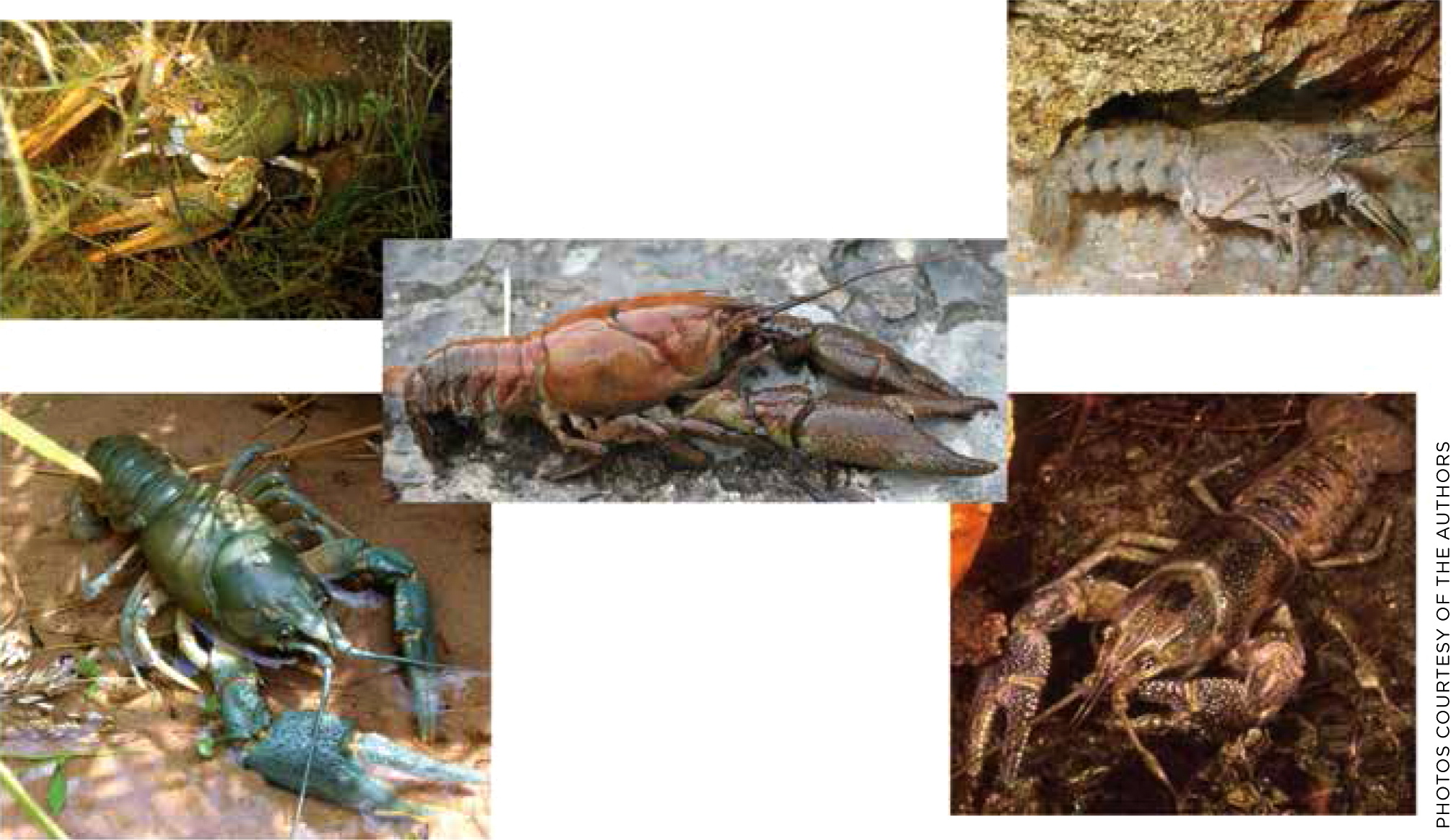

With the photographs behind us, we moved on to the next section of our lesson which was incredibly exciting for the students. We had ordered living crayfish from a science supply company, and each group of four students had a small container with two crayfish that they were to observe. See Endreny (2006) for information on caring for living crayfish. Before distributing the lidded containers, we reminded students that the crayfish were living organisms who should be treated with respect. We asked them not to remove the lids and to observe the crayfish and not tap on the containers. We provided students with a data collection sheet that required them to draw the crayfish in its container and to observe any visible behaviors (see NSTA Connection). Because we knew that the crayfish would not be able to engage in many of their normal behaviors in a small container, we supplemented our lesson with short video clips of crayfish swimming backward to escape from a predator, raising their claws in defense, hiding in plants, and capturing food. Each student group had access to two portable electronic devices and we provided a link to a Padlet site where we had uploaded the video clips. As students watched each video several times, they recorded their observations. On the data recording sheets, we asked students to focus on the connection between the behaviors that they were observing and how they helped the crayfish to survive in its habitat.
Once students had an opportunity to complete their observations, we came back together as a whole class to discuss what they had observed. During this portion of the lesson, we replayed each of the video clips and discussed them with the students. We used questions such as: What behaviors did you see? Why are those behaviors helpful to crayfish? and What needs are they meeting? to focus our conversation. The fourth graders recognized that by swimming backward quickly, the crayfish were able to escape while still being able to see their attackers. The students observed that the crayfish used their large claws for both defense and capturing food. See Table 1 for a discussion of crayfish adaptations. (We researched this content to be prepared ourselves and used this information to help guide students as they shared their responses to our questions.)
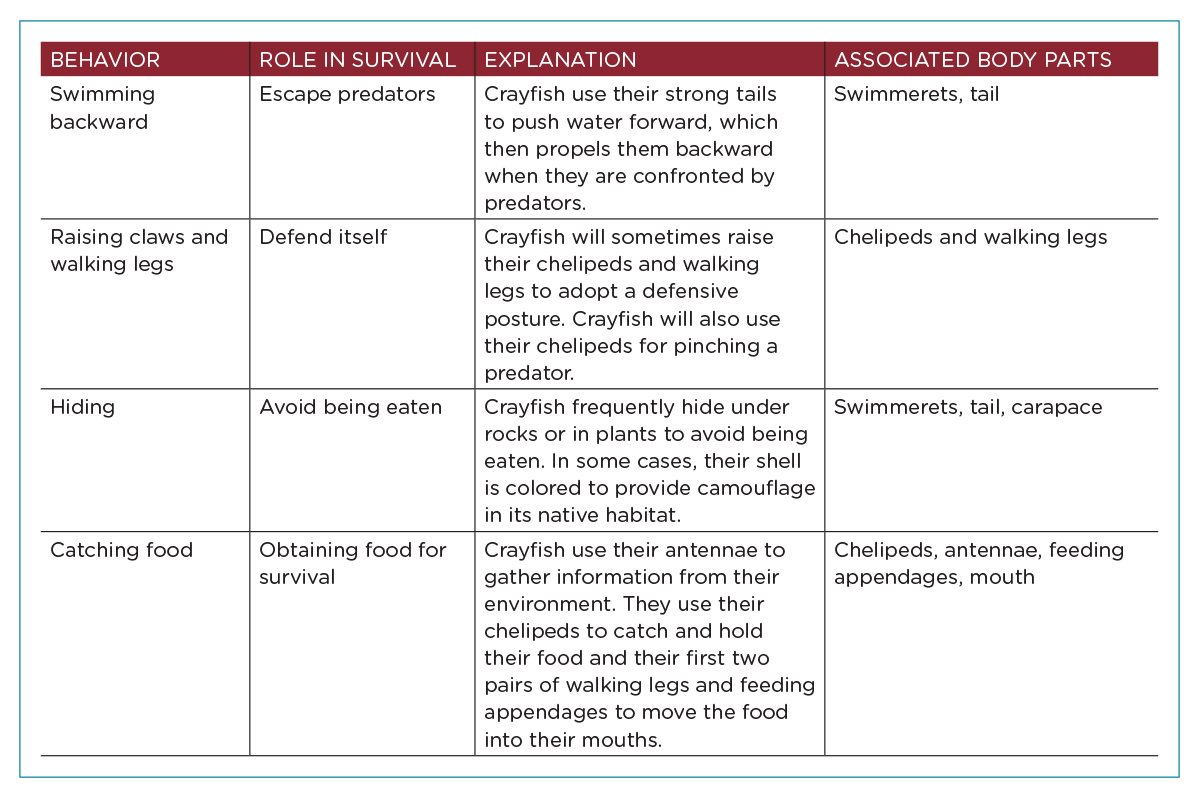
Information in the table was found in Kalman and Sjonger (2006) and www.ncwildlife.org/Portals/0/Learning/documents/Species/crayfish.pdf.
To end the day, we asked each student to begin work on a foldable where they would share their understandings from the first day of the lesson and would add to it on the second day (Figure 3, p. 58). At the end of the first lesson, we wanted students to have an opportunity to share their developing knowledge of how specific behaviors helped the crayfish survive. By providing this opportunity for the fourth graders to write about their experiences, our goal was to have students meet the Common Core State Standards (CCSS) goal for writing (CCSS.ELA-Literacy.4.1.B) related to providing reasons that are supported by facts and details and the scientific practice of Obtaining, Evaluating, and Communicating Information. To construct the foldable, we folded a piece of cardstock lengthwise (i.e., hotdog style) and cut three slits on the top piece of the cardstock, which made four discrete sections. On each of the sections, students wrote one of the behavioral adaptations we had observed and drew a picture of the crayfish engaging in that behavior. On the opposite side of the flap, students described how that behavior helped the crayfish to survive. By allowing students to represent their understandings using both pictures and words, we hoped to enable all students to share what they had learned, including struggling writers.
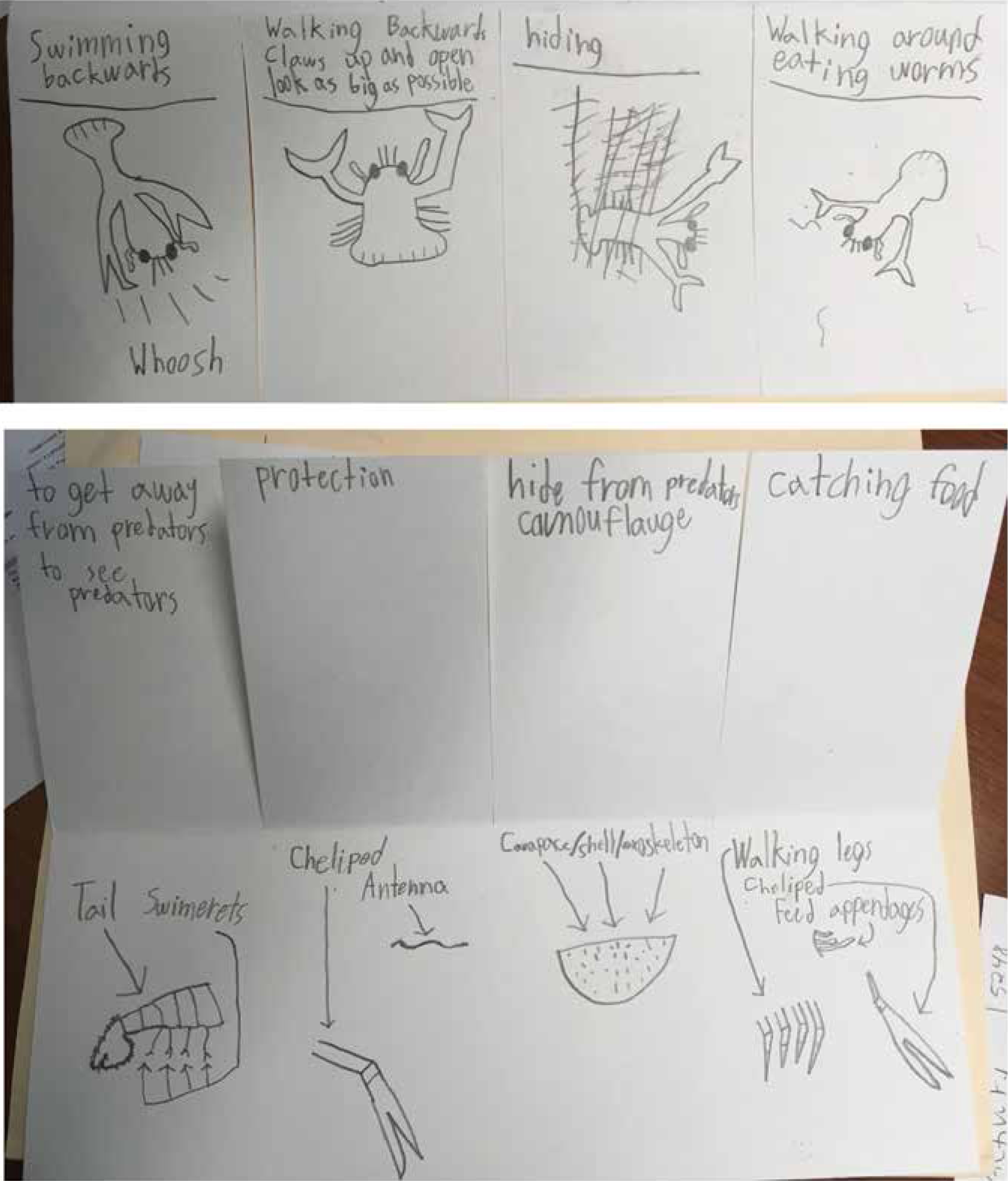
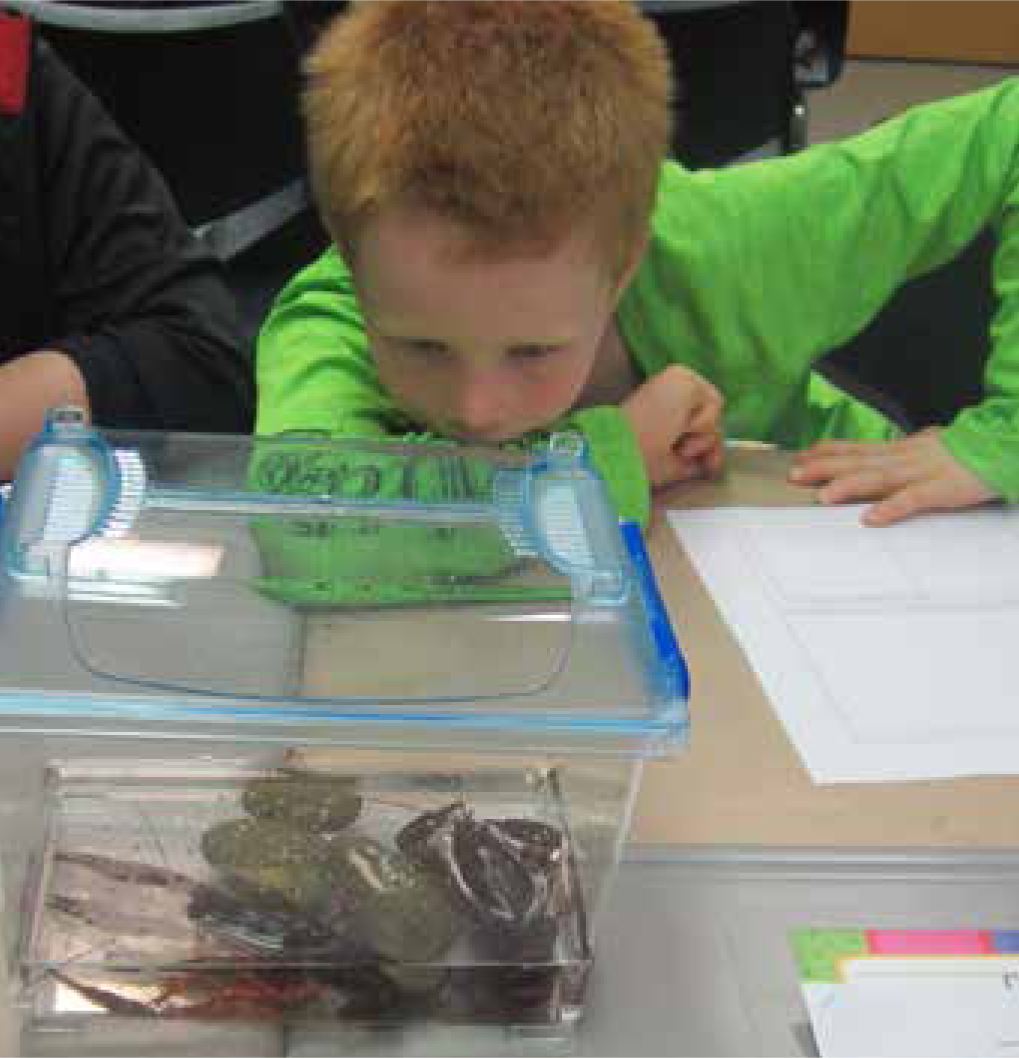
Day 2: Incorporating Literacy
We began the lesson on the second day with a brief review of what students had learned in the previous lesson. As a part of our discussion, we considered how we could see the behaviors of the crayfish using our videos and living specimens; however, we were not able to focus specifically on the structures that helped the crayfish engage in those behaviors because they were too difficult to see closely on a living crayfish who was in motion. We then transitioned to a new investigation. Rather than living crayfish, we provided each pair of students with a preserved crayfish purchased from a science supply company. Before passing out the specimens, we provided students with gloves and reminded them to be respectful of the animals and their peers. Because we wanted to be able to use the preserved specimens in future years, we did not want students to remove body parts or otherwise damage them. We asked students to observe as many structures on the exterior of the crayfish as they possibly could and to predict what each of those structures was used for. This activity provided an opportunity for students to focus specifically on Next Generation Science Standards (NGSS) LS1.A related to structure and function. In our original planning process, we wanted students to draw the crayfish as well, but because of time constraints, we eliminated the drawing step. Students were fascinated by the crayfish and were eager to call us over to show us different features or to ask us questions. The most frequently asked question was how to tell the difference between a male and female. Through our own research, we learned that in males the first pair of swimmerets would be longer and more fully developed and that females have an opening between their last two pairs of legs that are absent in males (Anders 2017) .
Once students had ample opportunity to observe their animals, we participated in a whole-class discussion about the various structures that the students had observed. We projected a diagram on the board and identified the parts that the students had seen on their crayfish. Each of the four classrooms where we conducted the investigations had students with widely varying knowledge of scientific vocabulary. We wanted to meet students at the level where they were but also to challenge them to grow in their scientific vocabulary. For several body parts that we discussed, we provided both a scientific name and an everyday word for it. For example, the large claws on the front of the crayfish are called chelipeds and the hard outer shell on the cephalothorax is known as a carapace. As we talked with students about the structures and how they helped the crayfish survive we used the scientific terms and common names interchangeably. Many students particularly loved the word cheliped and used it throughout the remainder of the lesson.
After we had discussed the different structures, we returned the foldables that the students had started during the previous lesson. On the remaining part of the paper, we asked them to draw and label the parts that helped the crayfish engage in each of the behaviors.
Once the foldables were complete, each pair of students received a plastic bag with approximately 1 cup of malleable homemade dough. We asked the students to use the dough to make a model of a crayfish. We provided each pair of students with a piece of aluminum foil to place on their desks. The foil was a good surface for the students to work on since it was nonstick. Once the models were complete, we helped the students transfer them to a piece of paper and asked them to label as many structures as possible (Figure 4). We encouraged students to use either everyday language or scientific vocabulary on their labels. The students were completely engaged in the model-building process and worked diligently to make their models as scientifically accurate as possible. We felt this model-building step was especially important as it enabled students to use information from multiple sources to demonstrate their knowledge of crayfish structures. The model building along with the completion of the foldables provided scaffolding steps to help students prepare for their final writing activity. The labeling aspect of these activities helped students be prepared to use correct terminology in their letters as they described the adaptations of the crayfish.
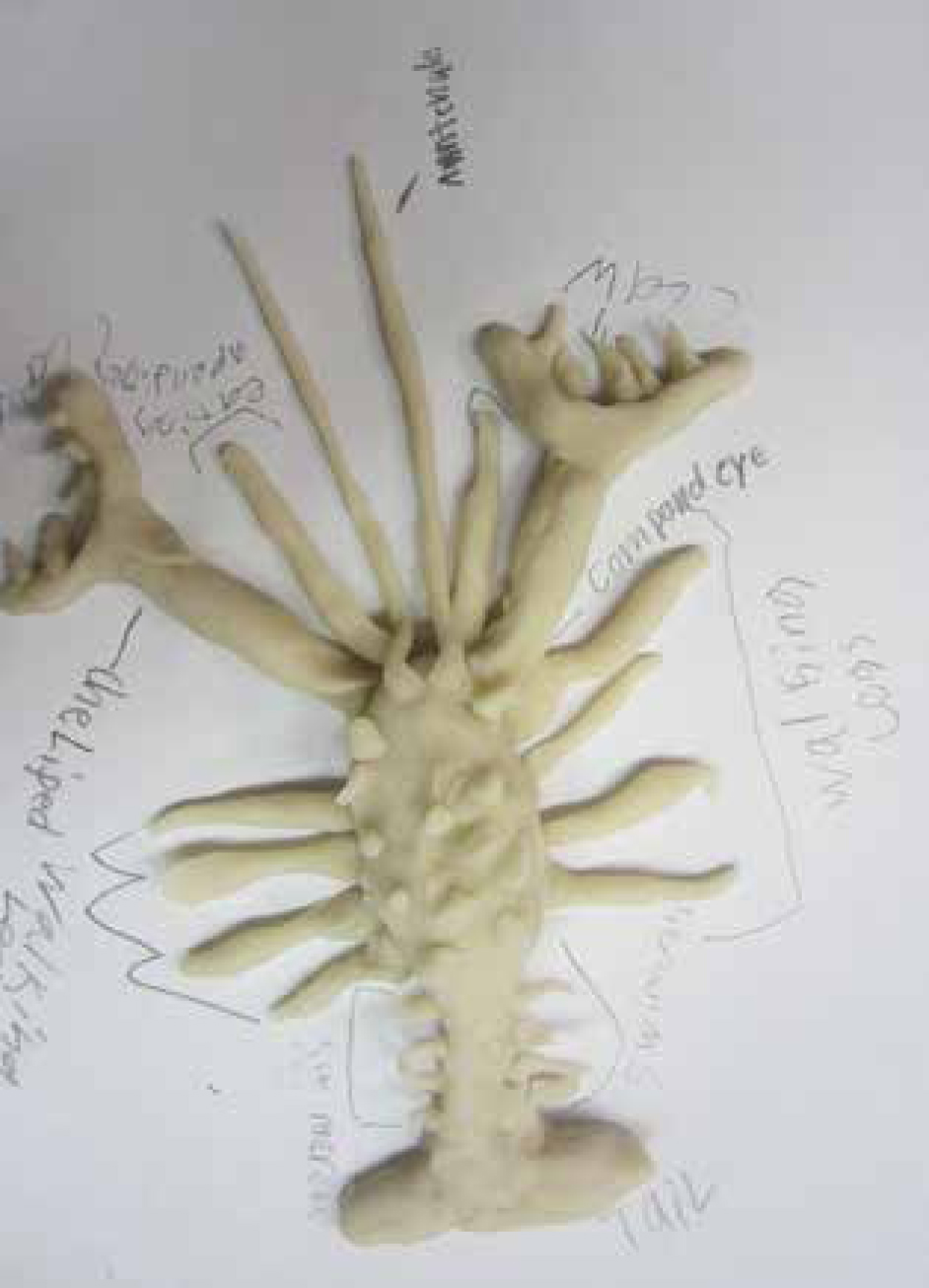
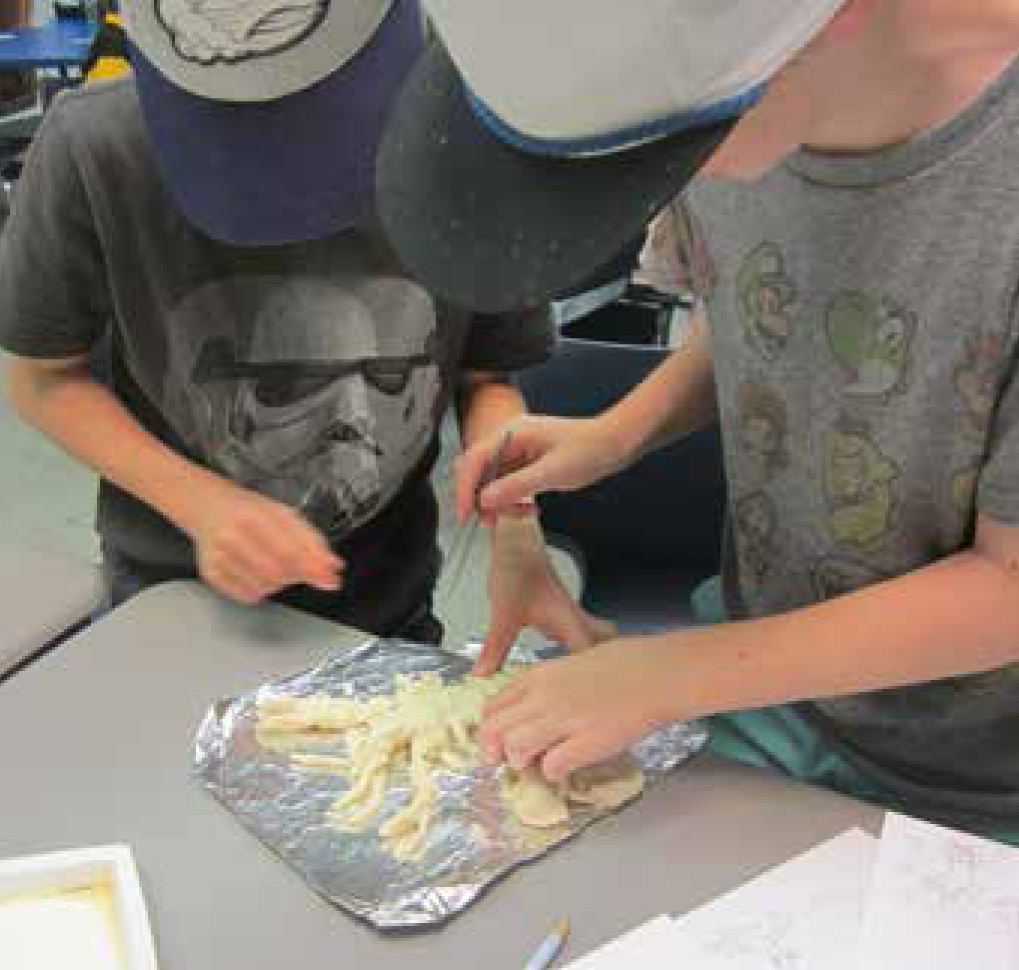
Because these students had recently returned from a field trip in which they got to dissect a squid, as a culminating assessment, we asked them to write a letter to a squid that explained how the structures and behaviors of the crayfish enabled it to survive in its environment. On their field trip, the fourth graders had been engaged in the squid dissection and very interested in the parts of the squid, we chose to have students write to the squid since they were another aquatic animal, and we hoped that the choice would encourage students to be engaged in the writing process. The parameters that we set were that the letter described at least four structures and/or behaviors that helped the crayfish survive and that students followed the conventions for writing a friendly letter; other than those guidelines, we left the assignment open-ended (Figure 5). We have shared a scoring rubric online (see NSTA Connection).
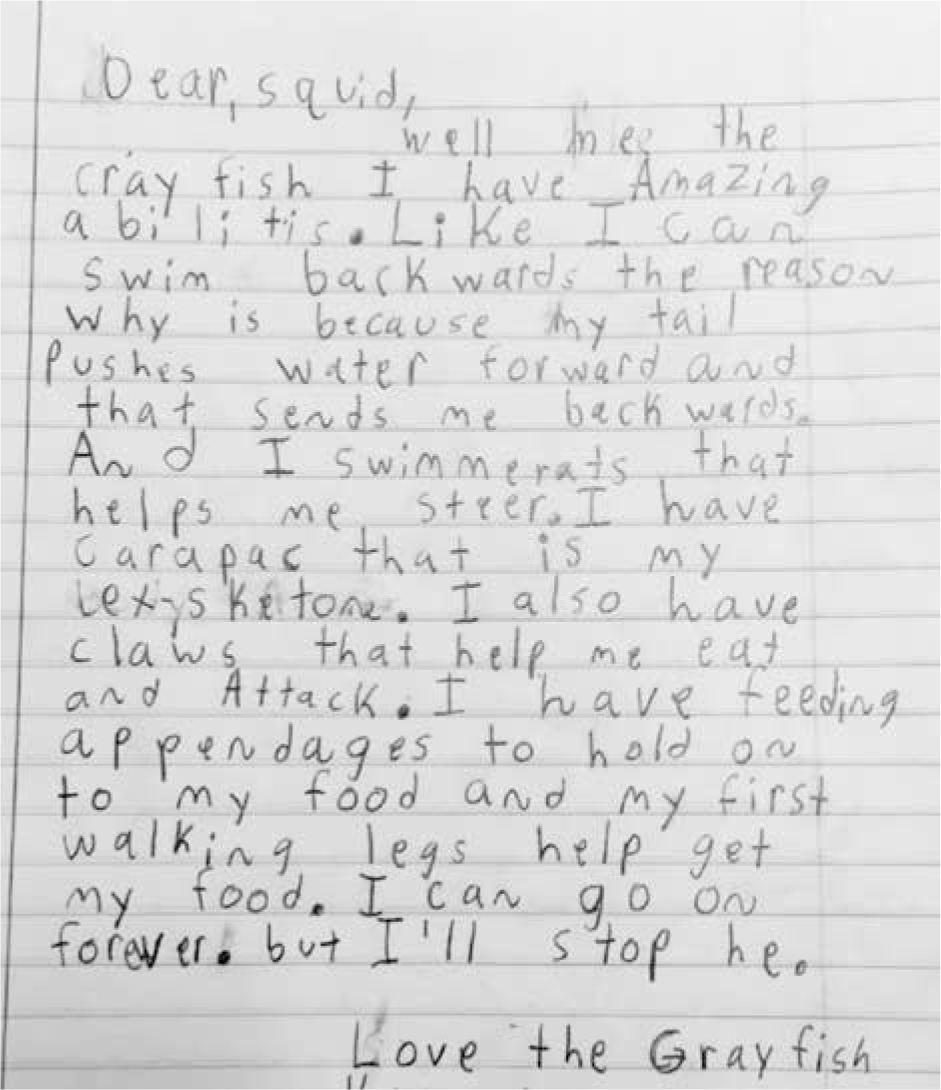
It was interesting to us to note how much variability there was in the final products. Some students chose to share the information in the form of a fictionalized story about how the crayfish had escaped a predator, while others wrote in a more traditional nonfiction manner. In his letter, one student made up a story about how the crayfish in his habitat had been attacked by river otters but went on to say that he had been able to survive because he swam backward and then was camouflaged by his exoskeleton. Another student pointed out that he wished that the squid and crayfish could meet, but that since the squid lived in the ocean and the crayfish lived in freshwater, it would be difficult to get together. While these examples were creative, most students listed the body parts or behaviors in their letters and then explained how they helped the crayfish to survive. Even students who frequently struggle with writing in other contexts were motivated to complete their letters because they were so excited about what they had learned.
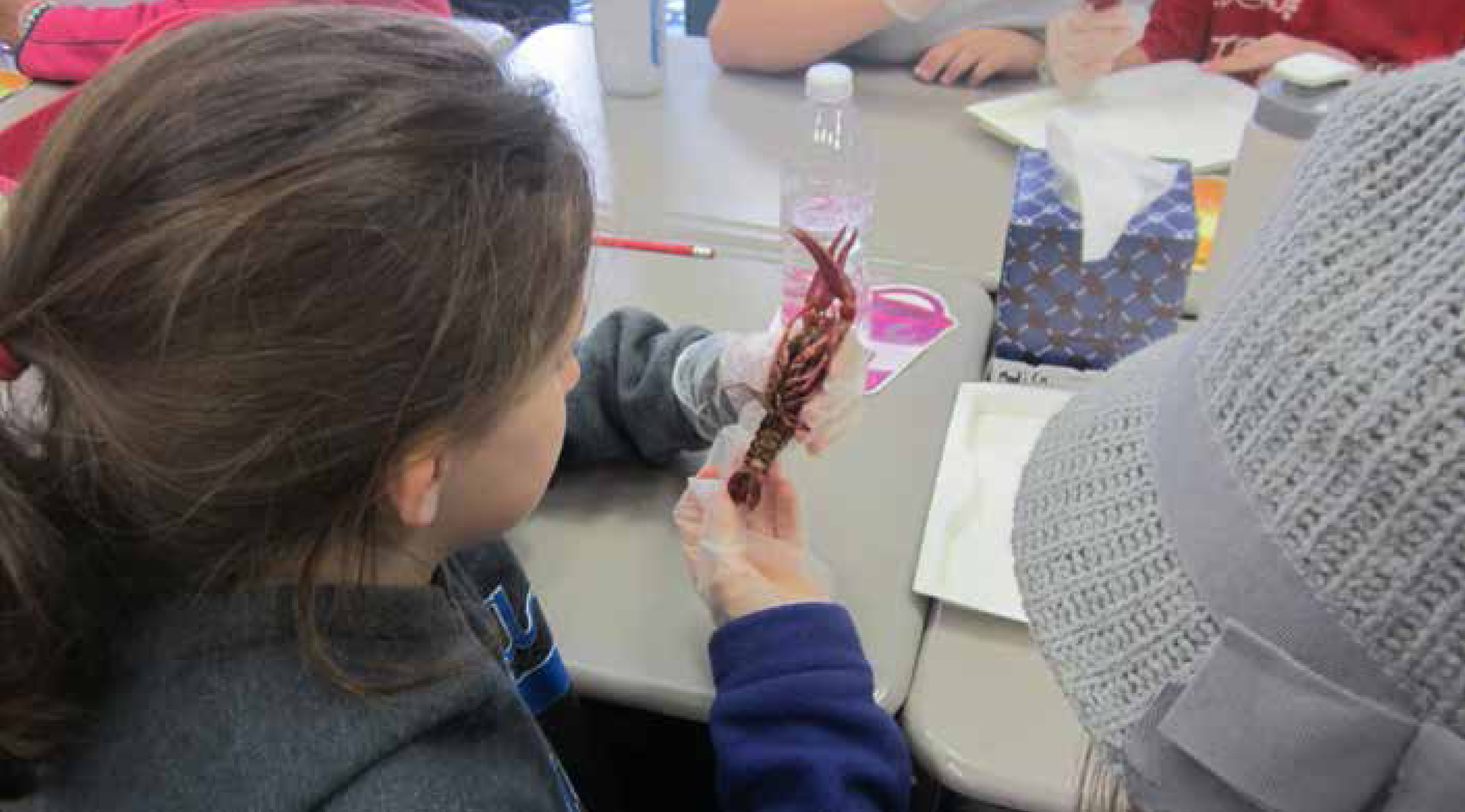
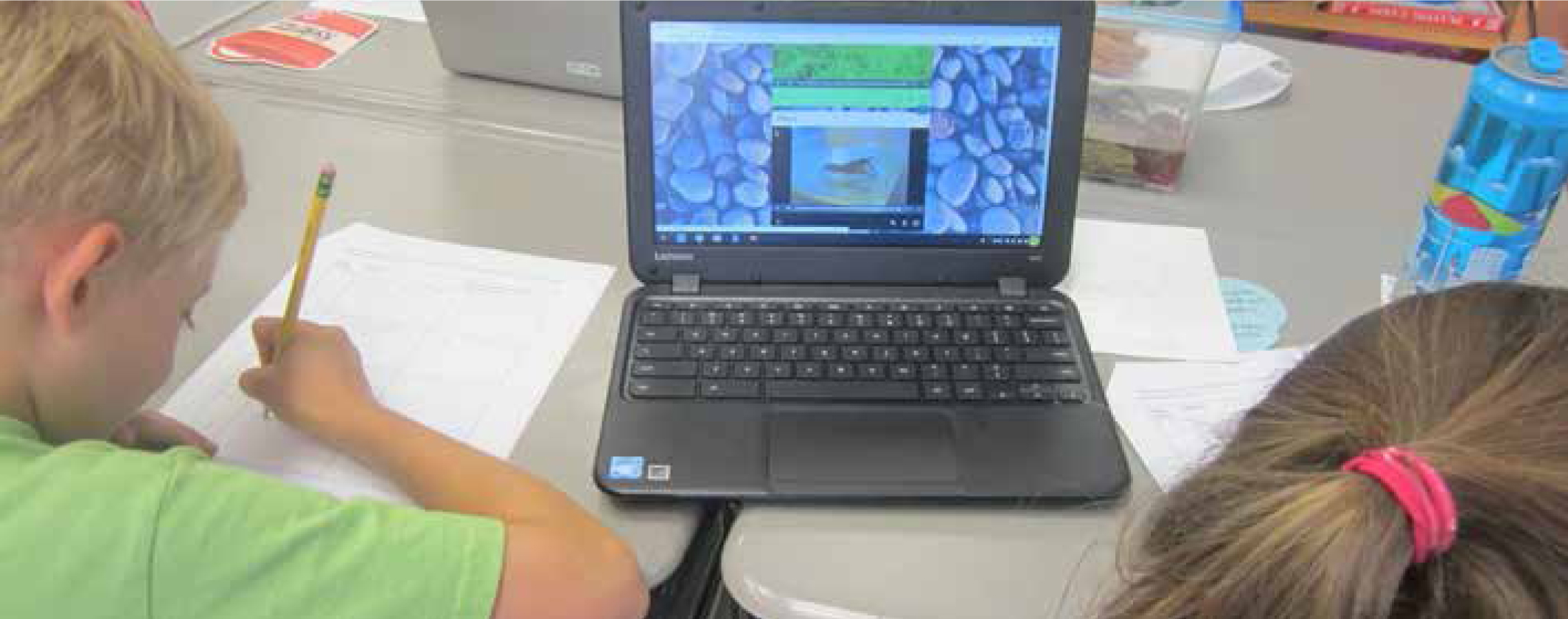
Conclusion
This lesson cultivated students’ curiosity about these fascinating creatures while helping students progress in meeting both NGSS standards related to structure and function and CCSS standards for writing. While we used crayfish for our activities because they are native to our area, the sequence of experiences in the lessons could easily be modified for use with other organisms. Given the living organisms and preserved specimens available from science supply houses, it may be possible to use frogs or praying mantises for the activities, or some other organism native to a particular area. Our experiences with this unit drive our own curiosity for developing additional lessons in which living organisms are the basis for integrating science and language arts learning opportunities.

